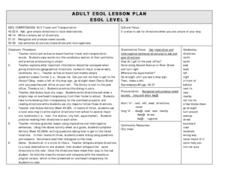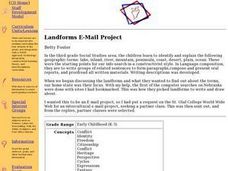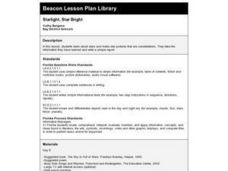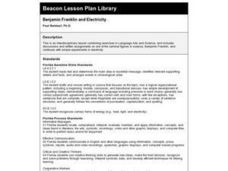Curated OER
Equation Translation
Students translate simple mathematical equations into sentences. In this equation lesson, students identify trigger words to translate simple math equations into sentences and sentences into mathematical equations.
Curated OER
What About Health?
Students examine the concepts of healthy and unhealthy drugs. They read and discuss excerpts from the book "The Human Body," develop a list of healthy and unhealthy drugs, and write sentences relating to safety about medicines and other...
Curated OER
Giving and Taking Directions
Students identify the difference between commands and a declarative sentence. They complete a diagram with verbs, prepositions and numbers. They follow directions using a map and give directions to another location.
Curated OER
Adjectives and Descriptive Phrases
Students examine the use of adjectives and descriptive phrases to improve their written pieces. In this adjectives and descriptive phrases lesson plan, students look at demonstrative adjectives, common adjectives, and proper adjectives....
Curated OER
Locomotor Dances
Students explore and perform locomotor movements. With partners, they combine the locomotor movements into a simple dance. The partner identifies three movements they observed. Students may be grouped into dancers for a performance.
Curated OER
Asking For Directions
Students draw a map of their surrounding area using appropriate landmarks and identifying characteristics. Students ask for and give directions to locations found on their maps to their partner. This lesson is intended for students...
Curated OER
Giving and Taking Directions (Middle School)
Middle schoolers describe the difference between a declarative sentence and a command. They complete a diagram verbs, prepositions and numbers. They follow directions on a map and create directions of their own to another location.
Curated OER
Landforms E-mail Project
Learners identify and explain geographic terms. They write descriptions of the terms. Students discuss landforms and draw pictures to illustrate them. Learners compose and present oral reports about landforms.
Curated OER
"The Selfish Crocodile"
Students participate in various shared reading and writing activities related to the book "The Selfish Crocodile" by Faustin Charles. They identify descriptive words from the story, and write sentences describing how the crocodile...
Curated OER
Ready, Set, Action
Students investigate parts of speech by analyzing action words in sentences. In this verb usage lesson, students read sentences to each other and identify the action words and verbs used. Students participate in a speed challenge in...
Curated OER
Starlight, Star Bright
First graders read books and use the Internet to identify several constellations and stars in the night sky. They make star pictures and write a class report about the night sky including a title, complete sentences and a cited reference.
Curated OER
Introduction to Linear Functions
Young scholars are introduced to the concept of linear functions. Using new terminology, they describe linear functions in sentences and in data tables. Using the internet, they calculate and record answers to problems which are...
Curated OER
Igga Bigga
Students explore consonant digraphs in written words and use them in their own sentences. They work with /th/, /sh/, and /ch/ digraphs. Students read The Little Old Lady Who Was Not Afraid of Anything and identify words with the...
Curated OER
Wacky Web Tales
Students study the parts of speech and then review them. They identify each part of speech and place them on a tree map. Then they visit a website to create a "Wacky Web Tale" using information from the tree map. They print their tales...
Curated OER
Cause and Effect
Learners identify cause and effect relationships in a short story. After reading a short story, they participate in a discussion of how one event in a story can lead to several others. Students are then paired for a matching task that...
Curated OER
Changing Verb Voice (Active/Passive) Practice
In this active voice and passive voice practice worksheet, learners read an informative lesson. Students then respond to 5 questions that require them to identify the voice the sentences are written in and rewrite them in the opposite...
Orange County Department of Education
Dancing Rainbows: A Pueblo Boy's Story
Third graders identify the main ideas illustrated in the story "Dancing Rainbows." They identify details from the story that show respect toward self and others. Students write a paragraph to illustrate how the Tewa Indians show respect....
Curated OER
Roll Out the Run-ons
Students participate in activities in order to investigate the concept of run-on sentences. They identify a complete sentence and the correct characteristics that it possesses.
Curated OER
Benjamin Franklin and Electricity
Second graders study Benjamin Franklin and participate in simple experiments in electricity.
Curated OER
Nouns
Pupils recognize common nouns and proper nouns and use them in proper paragraph form. They get the opportunity to play noun bingo. In addition, diagramming simple and compound noun sentences are undertaken within this lesson.
Curated OER
Little Engine That Could Lesson Plan
Students retell the story The Little Engine That Could by Watty Piper. In this early childhood lesson plan, students identify the various trains featured in the story, focusing on the descriptive words. Students then create their own...
Curated OER
Language Arts:Similes That Make Us Smile
Students identify similes and create their own self descriptions using them as examples. After identifying characteristics associated with pictures of the sun, fish, and other items, they discover how those traits can be used as...
Curated OER
It's Alive
Students identify the differences between a nonliving and living thing. They describe what is needed for any living thing to survive. They create one page for the class book identifying why the object is a living thing.
Curated OER
Writing Thank You Notes
Sixth graders write to a veteran. In this letter writing lesson, 6th graders identify the five parts of a letter and discuss the importance of sending thank you notes. Students write a thank you note to a veteran.























